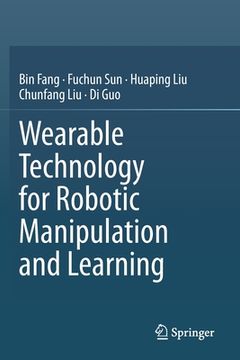Compartir
Wearable Technology for Robotic Manipulation and Learning (en Inglés)
Fuchun Sun
(Autor)
·
Huaping Liu
(Autor)
·
Bin Fang
(Autor)
·
Springer
· Tapa Blanda
Wearable Technology for Robotic Manipulation and Learning (en Inglés) - Fang, Bin ; Sun, Fuchun ; Liu, Huaping
S/ 918,51
S/ 1.530,85
Ahorras: S/ 612,34
Elige la lista en la que quieres agregar tu producto o crea una nueva lista
✓ Producto agregado correctamente a la lista de deseos.
Ir a Mis Listas
Origen: Estados Unidos
(Costos de importación incluídos en el precio)
Se enviará desde nuestra bodega entre el
Jueves 18 de Julio y el
Lunes 29 de Julio.
Lo recibirás en cualquier lugar de Perú entre 2 y 5 días hábiles luego del envío.
Reseña del libro "Wearable Technology for Robotic Manipulation and Learning (en Inglés)"
Chapter 1: Introduction. In this chapter, we present some backgrounds about robots, and discussions on the robotic manipulation learning algorithms. Then imitation learning methods are detailed described. We present the current studies on the wearable demonstration that the demonstrations are built by the wearable devices for imitation learning. In addition, we also discuss some existing challenges. The organization of this chapter is listed as follows. 1.1 Background 1.2 State-of-the-art of robotic manipulation learning 1.3 State-of-the-art of imitation learning 1.4 State-of-the-art of wearable demonstration 1.5 Existing challenges 1.6 Summary Chapter 2: Wearable inertial device In this chapter, we present the background about wearable inertial device, and detailed descriptions on the inertial sensors. The calibration methods of sensors and wearable device are developed. The wearable computing algorithms are presented. The experimental results show the performance of the wearable inertial device. The organization of this chapter is listed as follows. 2.1 Background 2.2 inertial sensors 2.3 Sensor calibration 2.4 Wearable calibration 2.5 Wearable computing 2.6 Experimental results 2.7 Summary Chapter 3: Robotic manipulation learning from indirect demonstration In this chapter, the background of the demonstrations is presented, and the indirect demonstrations are introduced. Then demonstration datasets and the experiments of indirect manipulation demonstration using proposed wearable device are described. And we propose the robotic manipulation learning method by integrating the crucial experience in demonstrations. Finally, we verify the developed methods via both simulations and experiments by grasping various shapes of objects. The organization of this chapter is listed as follows. 3.1 Background 3.2 Indirect demonstration 3.3 Learning method 3.4 Experimental results 3.5 Summary Chapter 4: Robotic manipulation learning from direct demonstration In this chapter, we provide an overview of direct demonstration. And we exploit the intrinsic relation between human and robot, then develop a novel mapping method that the operator's fingers are used for robotic hand teleoperation and the arms with palm are used for robotic arm teleoperation. Then a rotation invariant dynamical movement primitive method is presented for learning the operation skills. Finally, the effectiveness of the proposed human experience learning system is evaluated by experiments. The organization of this chapter is listed as follows. 5.1 Background 5.2 Direct demonstration 5.3 Learning policy 5.4 Experimental results 5.5 Summary Chapter 5: Vision-based learning for robotic manipulation In this chapter, an overview of the vision-based robotic manipulation is investigated. Then an end-to-end learning method is presented for learning the operation skills. Finally, the effectiveness of the proposed learning system is evaluated by experiments. The organization of this chapter is listed as follows. 6.1 Background 6.2 Vision-based learning method 6.3 Experimental results 6.4 Summary Chapter 7: Conclusions 7.1 Summary 7.2 Future work
- 0% (0)
- 0% (0)
- 0% (0)
- 0% (0)
- 0% (0)
Todos los libros de nuestro catálogo son Originales.
El libro está escrito en Inglés.
La encuadernación de esta edición es Tapa Blanda.
✓ Producto agregado correctamente al carro, Ir a Pagar.

